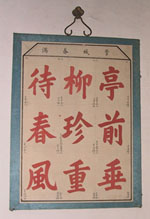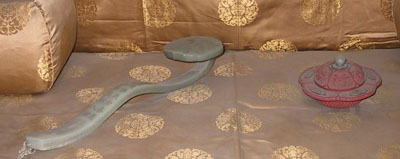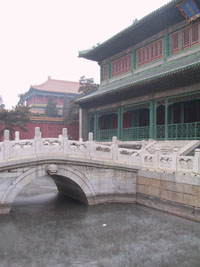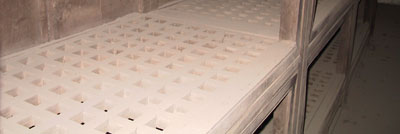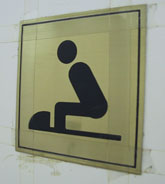Physicalized words
I can’t read Chinese, though I am able to at least distinguish it from Korean and Japanese scripts. (Cut me some slack, that’s progress! But don’t even ask about distinguishing Traditional from Simplified. I’ll have to be content in my ignorance on that one.) What this means is that, since I have no idea what idea is being conveyed, my growing love for Chinese characters is almost purely visual. A reverse ekphrasis, the strokes of even the most mundane lines are painterly, evocative of an artform more fully engaged with the space around it than Western writing. Chinese calligraphy, such as I have seen it, is more akin to dance or yoga than it is to other scribal arts. It is all very physical.
Consider the “calendar” in the image above. Called the 81 Days of Winter, it is a single phrase that evolves slowly over the course of the winter. Each day the author/painter adds one stroke to the characters; a total of 81 comprise all nine characters. Ticking off the days like an Advent calendar, the phrase is complete by the end of winter:
The weeping willow of the pavillion waits for the warm breath of spring.
But it isn’t just script that is spatialized.
The item on the left is called a Ruyi. Long ago it was an imperial backscratcher, but it eventually lost that function altogether and merely became a royal symbol. The item to the right is a spitoon shaped like a persimmon flower. Together they form a visual pun. The word “ruyi” also means (or sounds like) “whatever you wish” in Chinese. The word for persimmon also means “everything”. So, taken together, the two completely symbolic objects mean “everything you wish for”. You see these objects conspicuously placed together on furniture throughout the Forbidden City, a portmanteau resting amongst the other objects of daily life.
The Pavilion of Literary Profundity
Now that’s the way to name a library! Or, more specifically, a book depository. We braved the bitter cold at the Forbidden City in Beijing for a unique tour of this Ming-era building deep inside the palace complex. It isn’t open to the public as it is still used as storage for what looked like textbooks and promotional materials. Dust clogged the air and draped everything; if I were alone it would have been exceptionally creepy.
The upper floors were empty — much of the original corpus is in the National Palace Museum in Taipei, but they offered close inspection of some fancy stacking technology. (Ever since reading Henry Petroski’s Book on the Bookshelf I’ve had a low-level interest in the technologies of physically storing books.) Each section in the stacks are composed of two-ply shelves. The top shelf is a grid, to allow ample airflow in and around the volumes and scrolls. A second shelf immediately underneath the first is filled with sand. In the event of fire, this shelf would burn through (the theory goes) and dump fire-extinguising sand onto the level below. Rather ingenious.
Those Ming and Qing certainly were committed to fire abatement. Some 300 bronze vats were spread throughout the grounds for ready access to water (heated by fire in winter to keep it liquid). Protection was sought symbolically as well. The roof of the Pavilion of Literary Profundity is colored black, an atypical choice in the Forbidden City, but one that connotes water in the Chinese spectrum. Dragons spew water at the corners of the building and a huge lighting rod and cable snakes across the spine of the roof into the ground. All combined, an admirable long-term data preservation strategy. (More photos at Flickr.)
Virtual flâneur
Amazon’s A9 search engine is impressive, offering smooth, dynamic filtering of results and nice integration with the store and affiliated sites, but I’ve never been able to use it exclusively. It is tough to go cold turkey from Google’s simplicity. Actually, some of A9 is powered by Google, so maybe the strategy is not to dominate, but to provide certain niche services or enhanced applications. If so, A9’s new Yellow Pages search fits that bill nicely.
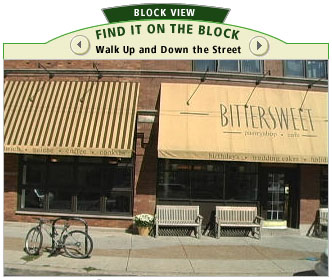
Amazon sure doesn’t shy away from brute-effort labor-intensive data entry. A while ago they hired transcriptionists to enter the text from thousands of books so you could search “inside the book” for most of their titles. Now they’ve paid a phalanx of digital photogs to capture images block-by-block in major cities so that you can actually walk up and down streets virtually as you search for services, products, and the like. Is this screaming for a head-mounted display and GPS integration, or what?
Forboding signs
I mentioned being disinfected on the approach into China. Maybe I spoke too soon. Turns out my entire family back home has been completely waylaid by some Stephen King strain of influenza. Fevers, painful coughing, locusts, general pestilence — all coming down at once. The disease vector this time was — surprise — my kids. My father-in-law calls children “poison dwarves” and he ain’t kidding. Sometimes I think my son’s school is a front for a biological weapons laboratory.
So here I am on the other side of the planet worrying that a time-release virus is waiting for the most inopportune time to blossom into full-blown misery for me. I’m OK now, but I just know I’m doomed. So I get the name of some potent flu-prevention meds from back home and think, what the hell, I’ll see if I can get them here. I slip the bellboy a note and some RMB and ask him to find me the best Oseltamivir Phosphate he could find. He scurries off and only then does it occur to me that I’m probably going to be hauled off to SARS quarantine or something. Then I recall that the newspapers on the plane mentioned the latest bird flu outbreak in Vietnam and Thailand and the steps China is taking to keep it out. So, if the virus doesn’t get me, the anti-virus police will. Nice going, John. We’ll see what happens tomorrow.
What luck that I should discover that my hotel room is actually outfitted with dual gas masks, should I develop symptoms of influenza (or bird flu!) and not care to infect my co-workers. The best part of these beauties: pop-top lids. Like they should be in the minibar or something.
Here are two of my favorite pieces of signage today. The first is a gem from the Forbidden City in central Beijing. Apparently, it wants to be loved just like everyone else.
And lastly, this pictogram. To many people this says “squat toilet ahead.” To some it says “impossible feats of human levitation ahead.” To most Westerners, however, it simply says “run away, run away fast … and clench!”
ORD -> PEK
Last week I was in China for work. Here’s the first in a series of posts that didn’t quite make it up in real time.
This is my third time to China in the past year, but only my first time doing it via a “normal” route. The first time was by going east from Chicago for work in Europe then continuing onward to the Far East and eastward still across the Pacific home. That was awful. Destroyed me. This past summer because of scheduling conflicts I had to take some godforsaken cattle-hauler out of LA at midnight. How pleased was I to be booked on a direct, non-stop flight from Chicago to Beijing this time!
You know, it still sucked. No matter how you slice it, 14 hours on an airplane is just brutal. And it does not help that United personnel appear to be defending their 2004 title of World’s Snippiest Flight Crews. Man, those people are just bitter. If they were half as chipper as their discount-fare faux persona Ted it would be bearable, but as it is now you feel like you’re imposing on the airline itself just occupying a seat that needs to be served a cold beverage.
Chinese law requires the occupants of inbound airplanes to be disinfected just prior to landing by flight attendants who run up and down the aisles with something like a cannister of Right Guard. But it ain’t deodorant. I don’t know what it is, or what exactly it does, but it is an endearing little welcome ritual. Like we’re being perfumed for entry into the presence of royalty or something.

More endearing still, in an odd way, is the mural of the Great Wall painted behind the stalls of the passport control agents that greet you upon arrival. Is it me or is the depiction of a massive rampart meant to keep foreigners out of your country (and ineffectually at that!) the best welcome mat for visitors? Welcome to China … it could be worse.
And the construction cranes! I have never seen quite so many in such density. Yes, I’ve heard that something like 60% of the world’s cranes are in Shanghai right now, but I figured that was exaggeration — probably is. But the Beijing airport is a veritable forest o’ cranes. Perhaps this is where they grow them? Perhaps they are prepping a new terminal for the Airbus A380 flying casino/health club/theater/plane?
One last thing before I nod off. The greeting of guests by name as they walk in the door of the hotel and the escorting of these guests straight to their rooms without stopping at the front desk and the checking in of these guests in the room itself — yes, all that, I love it. Wish all hotels would do that.
Zombie comedy
Some people with whom I’ve shared my Netflix queue using the new Friends feature think I watch too much horror. True, some of the worst movies I’ve rented fall into this category. Maybe that’s what makes Shaun of the Dead such a great movie. On the surface this British “romantic comedy with zombies” is just a parody of the undead-run-amok flick. But also in way it is a double-parody, implicitly mocking the now-established horror parody subgenre (think Scream and its offspring).

The movie is simply hilarious. A scene where Shaun argues with his slackass friend about which of his vinyl record collection they should fling at approaching zombies approaches perfection. And you just know the whole time that the final stand against the hordes will happen at the local pub.
Describing zombie behavior, one of the characters notes that they are “Vacant, with a hint of sadness. Like a drunk who’s lost a bet.” This parallel between the modern slacker and the classic revenant runs throughout the film and provides seemingly endless fodder for joke-making.
OK, back to the crappy horror in my queue …
Colbert on NPR
Kinda fun interview of Stephen Colbert, Senior __________ Correspondent for The Daily Show, on Fresh Air today. It’s always nice to pull back the curtain on the fake news. But like seeing a radio DJ for the first time, listening to Colbert so eager to have a serious conversation was a bit disconcerting. He was funny, of course, but his asides knocked Terry Gross off-kilter a bit. Which is fun to hear in itself. Have a listen.
Moleskine mod
Moleskine notebooks are somewhat faddish right now, but damn they are useful. And there are plenty of sites out there that detail ways to make them more so. Moleskine hacks, so to speak. Here’s my own: a holding mechanism for the Fisher Space Pen.
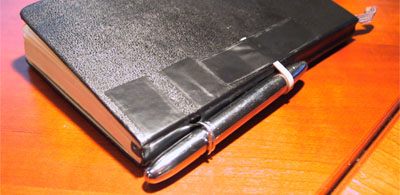
I wanted a way to join the notebook and the pen so I would not have to dig for either when I need them in a pinch. The problem was that the Fisher has no clip and is very slick. So I bent a paperclip to snugly grab the pen where it’s sheath ends and affixed a rubber band to hold the other end. It ain’t pretty, but it works.
UPDATE: My little MacGyverism hacked me back. Turns out the paperclip snip created a flesh-digging edge. Must work on 2.0.
TivoToGo, VCR NoGo
Well, well, well. I woke to the long-awaited TiVo system update this morning so, naturally, I’ve been playing with the video extraction to PC all day. The interface, as you’d expect, is fairly elegant and pulling files down is simple, though painfully slow. When, oh when, will you not throttle all networking through a dinky USB 1.1 adaptor, TiVo? To my surprise, it is even fairly easy to circumvent the DRM so the video files will play anywhere and can be burnt to DVD without buying the special Sonic software. Best of all is that the TiVo box now includes a webserver (like my trusty Audiotron) which allows you to check your Now Playing queue and download video from any web browser. There’s even an XML version. This is all ripe for hacking; I can’t wait to see what projects sprout from this (undocumented!) feature. (I maintain that TiVo’s product launch was completely premature, though!)
The irony? In a project completely unrelated to TiVoToGo I spent way longer than I should have trying to dump a 7 minute DVD video to VHS for my grandmother. I couldn’t do it. The rewiring necessary to perform this seemingly simple operation was too daunting. It is like I have pushed off one end of the video technology spectrum with TiVo and can no longer get back to the other end. Ah, progress. Sorry, grandma.
Mine!
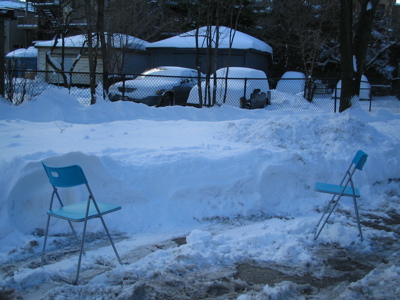
A few weeks ago we got quite a load of snow, but I was shocked to see not a single piece of household detritus placed in the street to claim a parking spot that had been carefully shovelled out. You see, the thinking here normally holds that if you go to the effort to excavate your car you shouldn’t have to cede the spot to some lazy schmuck when you drive off. This “tradition” of essentially claiming a property right for what is not yours is openly condoned by City Hall and often derided by suburbanites who love to highlight the irony of such un-neighborly conduct by the very citydwellers who bemoan the lack of sidewalk-centric community bonds in the suburbs.
Well, my worry was for nothing. This weekend we got an even bigger winter dumping (though not as big as what’s pounding the east coast) and, true to form, the crap is piling up in the street. Derelict couchs, two-by-fours, plastic lawn furniture — whatever can be tossed into the spot to prevent a would-be spot-stalker. There’d been some talk that gentrification was slowly killing this tradition, presumably because yuppies have garages and they like their streets not to look like the aftermath of a flea market. I’m happy to report that this does not seem to be the case. However, I will suspend final judgement on this trend until I see an altercation over a shovelled spot. (Certain brave drivers will actually move the impromptu barricades off the street to get a spot.) Only if the dispute ends in one neighbor deliberately icing another’s car with a hose will I consider the tradition to be thriving.

